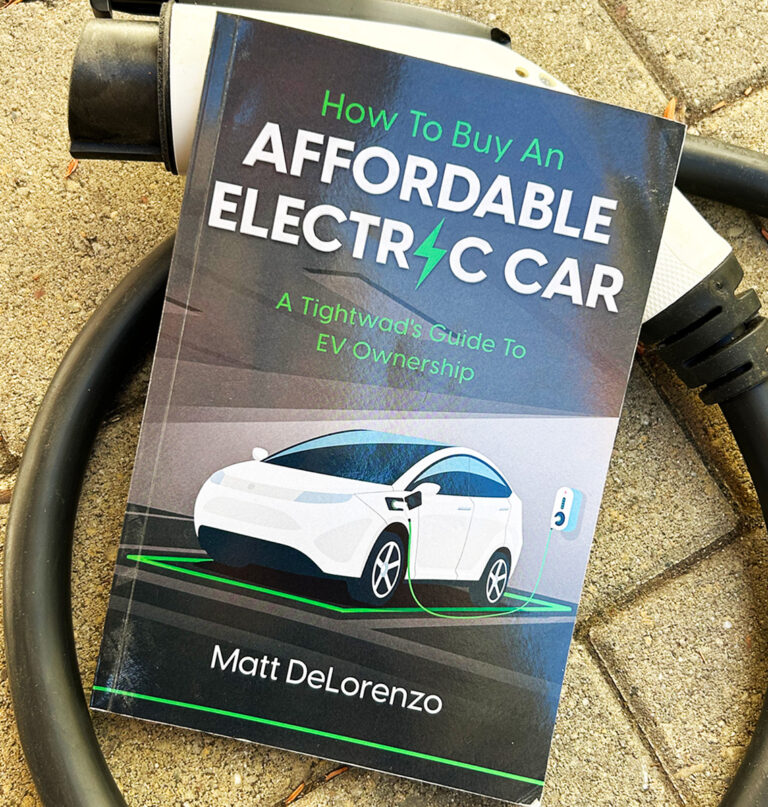Book Review
“How To Buy An Affordable Electric Car - A Tightwad’s Guide To EV Ownership”
by
Matt DeLorenzo
Contrary to all the sexy TV commercials, their billionaire backers and the the idea electric cars are cornucopias of technological wizardry, EVs are nothing new.
In fact, the first successful American EV rolled through the dusty streets of Des Moines, Iowa, in 1890. Created by Scottish immigrant and inventor William Morrison, the vehicle carried 12 passengers, cruised at nearly 12 miles per hour, and had a range of 50 miles.
While its speed might not have been breathtaking, the range of Morrison’s invention was not far behind what modern EVs were managing just a few years ago. Luckily, the distance today’s electric vehicles can cover has increased significantly and continue to improve with breakthroughs in battery technology and energy management.
These advancements along with the growing acceptance of this new mode of transportation, have created tremendous opportunities for the EV consumer.
Would-be owners, however, are discovering that the transition from traditional gasoline-powered vehicles to ones powered by electric batteries is not a linear exchange.
Decisions, Decisions, Decisions
“How To Buy An Affordable Electric Car – A Tightwad’s Guide To EV Ownership” – the latest book by renowned automotive journalist Matt DeLorenzo, could not have arrived at a better time. The book promises a conscientious way to enter the market as it offers insight to the latest vehicles and helps readers decide exactly which EV matches their budget and lifestyle.
It might have been tempting to focus on the high-end models from Tesla, Mercedes, or Lucid, but DeLorenzo takes a pragmatic view and focuses on entry and mid-level EV models. This segment is expanding at a lightning pace with impressive models being introduced by Kia and Hyundai.
The New Hip-mobile

Once viewed as the elite people mover, electric-powered and hybrid vehicles are becoming commonplace in the urban landscape.
Buying an EV, however, involves more than simply kicking the tires and choosing what trim to add. An electric vehicle’s theoretical miles-per-gallon rating is essential to compare to a traditional gasoline-powered car properly. Still, it should not be the deal breaker. What is perhaps more critical is the distance the vehicle can travel between charges.
This range, or more correctly, lack of range, has introduced a new phenomenon to the automotive world—range anxiety. A palm-sweating, jaw-clenching anxiety that can creep into a driver’s mind when the charge indicators on his flatscreen dashboard begin to drop and there is not a charging station in sight. Add to that is the worry that there might not be a charging station at their destination. Luckily, the battery range has been growing steadily. Even mid-priced EVs can easily cover two hundred or more miles on a single charge.
A New Lifestyle
It is hard to deny that cruising the neighborhood in a 21st-century automobile with piercing Xeon headlamps and a sweeping, liquid-crystal dashboard has a cool factor about it. But a potential owner must ask themselves if such a vehicle fits their lifestyle.
Sales of EV are certainly growing, and world-governments are beginning to adjust their policies to promote this expanding market, but full compliance and infrastructure will take time. It is easy to imagine there was similar reaction to steam-powered automobiles when they began to replace the horse and buggy.

Sorting It All Out
If there is an electric vehicle in your future, or you are simply curious about all the fuss, then DeLorenzo’s book is a must-have. It is filled with both commonsense views and critical information about such a purchase.
In Chapter 3, DeLorenzo reveals how it all works and in Chapter 4, what to expect slipping behind the wheel. Chapter 5 discusses the nuts and bolts of purchasing an affordable EV. While this might sound like an oxymoron, the author points out there are many ways to align your transportation needs with the value of specific models.
The book’s ‘tightwad’ premise points to the generous tax credits and incentives currently helping buyers close the monetary gap between electric and traditional vehicles.
The benefits of buying a zero or low-emission vehicle in the United States, as well as in other countries, can come with significant tax breaks or refunds. These incentives were once based on the number of models sold by each manufacturer, but the rules and laws are changing.

Buy or Lease
DeLorenzo points out that leasing an electric vehicle is an excellent alternative to purchasing. Leasing is akin to a long-term rental, and the option depends on your type of automotive ownership — are you the type who keeps a car for decades or one who enjoys having the latest set of wheels in your driveway?
Leasing has an extra benefit with electric vehicles. The technology driving the market segment, both with battery development and electric efficiency, is evolving faster than Apple can release the next iPhone. Range is lengthening, recharging times are shrinking, and overall system components continue to improve.
The cars are simply getting better at an exponential rate. By leasing, you are not bound to yesterday’s hardware or technology but remain at the wheel of the newest version simply by renewing your lease and taking delivery of the next model to hit the showroom floor.
In chapters 6 and 7, DeLorenzo explores the current models and reveals the most sensible ways of making a deal. He touches on the idea of buying a used electric car. This might seem unwise advice, but the author points out that most EVs are sold with substantial battery warranties.
Considering most electric cars are expected to be used for short, around-town excursions, it is unlikely a three or four-year-old model has outpaced its warranty. That said, it is vital to read the fine print in the manufacturer’s warranties.
A Home Fueling Station
The most significant lifestyle change involving the electric car era is the realization that your home can be your private fueling station. It is hard to overstate the convenience of ‘filling up’ in your garage.
DeLorenzo gives an excellent breakdown of the requirements and options for installing a home-based charging unit. He also discusses potential electricity costs and whether a home solar system is a beneficial investment to couple with your EV.
Recharging on the road is, of course, is a central question when considering an electric vehicle. DeLorenzo reveals that the concern over the current level of infrastructure is one of the most problematic aspects of EV ownership.
Considering the financial stakes, the automotive industry is putting toward research and development, the required infrastructure must expand beyond its current level. eLorenzo lists over a dozen charging companies already vying for a portion of the pay-per-kilowatt charging market.
Conclusion
In the final chapters, DeLorenzo looks at the alternatives to the pure electric vehicle. He explains and evaluates the hybrids, the class of car that couples electric power with a gasoline engine to stretch its MPG. Given their ability to offer the best of both worlds, good gas mileage and peace of mind, a hybrid, or its more electric-leaning sibling, the plug-in hybrid, might be an alternative to consider.
Regardless of which EV ultimately fulfills your automotive needs, DeLorenzo’s book, “How To Buy An Affordable Electric Car – A Tightwad’s Guide To EV Ownership” – is a essential addition for your automotive library. Its pages are a solid source of information and research.


